Good copywriting can generate up to 8x more traffic.
Don’t you want results like that?
You just have to master the essentials of good copy.
Like SEO or content marketing, it all comes with practice and time.
But, you may be holding yourself back from getting the sales and traffic you want. The culprit? Poor copy.
Small changes to your copywriting can make big increases in conversion rates.
Instead of showing you what to do, I’m going to show you want not to do.
Are you making these copywriting mistakes?
1. Less features, more benefits
One of the most common mistakes when writing sales copy is not focusing on the benefits of the product. Stating the features is necessary, but don’t forget to speak about how the customer will benefit.
What do I mean by this?
I’ll give you an example of when I ran a men’s shoe e-commerce business.
I was selling high-end exotic dress shoes, some made of python, crocodile, and even stingray leather. They were all handmade and hand-painted. Very pricey, as well.
The product description copy would look something like this:
- Brown genuine calfskin leather
- Hand-painted upper and outer sole
- Leather lining and insole
- Goodyear welt construction
If I’m selling shoes, of course, I have to mention the colour, materials, etc. It only makes sense, right?
But, here’s how I made the sales copy more feature-rich:
- Brown genuine calfskin leather that will catch the eyes of everyone around.
- Hand-painted upper and outer sole, making your pair unique to you only.
- Comfortable leather lining and insole that feels like walking on clouds.
- Goodyear welt construction to make your shoes last decades.
See how much better that is?
I’m stating the feature, but also how the customer will benefit.
If they are buying expensive shoes, they want to get their money’s worth while feeling and looking like a million bucks. Customers all want shoes that feel great on their feet all day, too.
Here’s another great example from Wayfair.
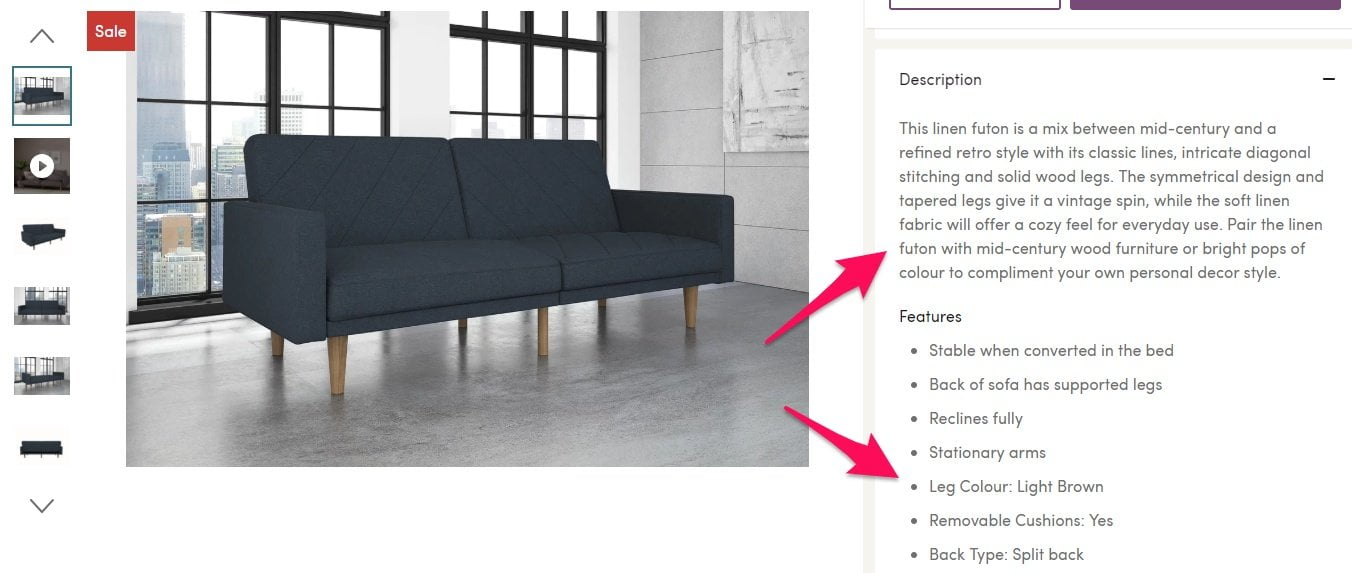
They list the features in bullet points so customers know exactly what to expect when they receive the product.
But, look at the product description. It talks about how it will match the customer’s style while being comfortable for any activity. Take notes!
Good copywriting like this stems from knowing your customer, as you can adjust it to their wants and emotions.
I’d suggest creating a consumer persona to begin. This is a representation of your ideal customer. There are lots of great templates to work off of like this one from Xtensio.
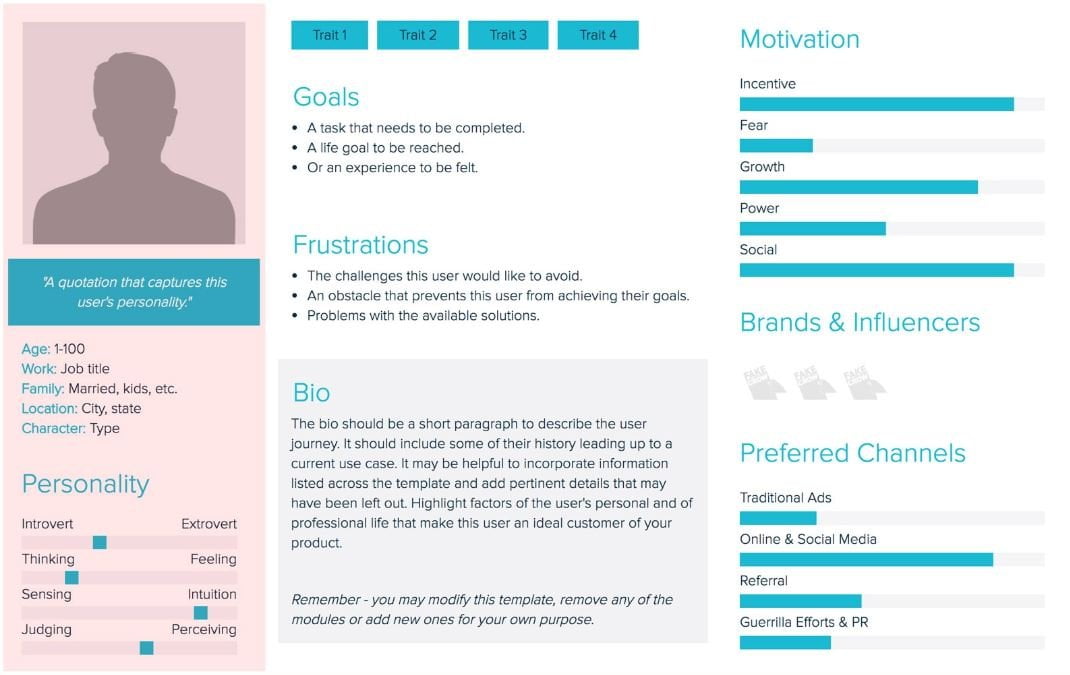
If you’re starting out or don’t have a lot of data on your customers, fill it in to the best of your ability. The whole point is to make a persona that you can refine and optimize over time.
Think about what your ideal customer struggles with, what they want in a product, how much money they make, and similar information.
With big data being all the craze these days, I think we are forgetting about different demographics. Everyone’s focusing on age, gender, location, and standard metrics.
But what about things you can’t measure?
Like goals, values, emotions, interests, and skills?
You might find that your customers come from a variety of age groups and countries, but match when it comes to the above demographics.
What do your customers value the most? Comfort? Price? Style?
Do they want to achieve financial freedom and independence?
Which emotions are they feeling as a result of not having your product?
Brainstorm things like this and let it reflect in how you write benefits in sales copy. Also, use this information to change how you speak to your audience.
Do they have a very deep and intelligent vocabulary? Or would they prefer a simpler language?
2. Writing weak headlines
The goal of writing headlines is to do one thing…
Make the customer read the first sentence.
And the goal of the first sentence?
To make the customer read the second sentence.
I learned this from Joseph Sugarman’s copywriting book, which if you haven’t read, is one of the best books on developing copywriting skills to date.
If your headlines suck, nobody is going to visit your blog, product page, or whatever you may be promoting.
Let’s look at what happens when you do it right.
Wilson HTM is an investment group that partnered up with Web Profits to improve its website copywriting. Specifically, they wanted their headline copy improved.
This was the first variation that Web Profits tested.

Then, they tested out this second variation.

Nothing drastic or crazy, what do you think the results were?
If you guessed a 52.8% increase in conversion rates, then you’re right!
Here’s what I think this worked so well.
It addresses investors head-on by using the call-out “Attention Investors” and asking them a direct question. It gets them saying yes and makes the message more personal.
As well, by stating that founding investors manage their funds, leads understand their money is in good hands.
Think about the revenue or leads you could generate if you fixed up your headlines.
Make sure to read my guide on website copywriting to learn more strategies like these.
State exact numbers
What sounds better, “10 SEO Tips to Improve Rankings” or “10 SEO Tips that Increased my Traffic by 67%”?
The second one of course.
Numbers are easy to process and gives the reader a heads up of what to expect if they read the article.
Mentioning exact numbers in your headlines makes them more enticing to click. Metrics like these helps you appear more credible and authoritative, too.
It’s been proven that headlines with numbers are 36% more popular than those without.

Use urgency
One of the most timeless copywriting strategies is the use of urgency.
It makes readers or customers feel that they must take action now or they’ll miss out on something. Maybe it’s knowledge, the latest sale, or an awesome product.
Want to know a great example of urgency being used in a headline?
Re-read the one I used for this article!
It promotes urgency because it makes you want to know if you’re making the mistakes I’d be outlining.
Some words and phrases to include in headlines to achieve this are:
- Hurry
- Stop doing this
- Start doing this
- Before it’s too late
- Quickly
- Soon
- Are you doing X?
- Today
- Now
Marcus Taylor upped his sales by 332% (Yes, really) by making his sales copy incite urgency in customers.
Ask a question
One of the reasons that the Wilson HTM case study performed so well was because they used a question within the headline.
If you can get them saying yes, they will be more likely to say to your product. Another classic Joseph Sugarman strategy.
So, next time you are crafting a headline, try to form it into a question. Like:
- Don’t Know how to Make a Website? Step by Step Guide
- Confused About Mutual and Index Funds? Full Comparison
- Are you Making These Crucial SEO Errors?
3. Speaking too much about yourself
Imagine you walk into a retail store. It’s a sunny afternoon on the weekend and you felt like doing some shopping.
As you enter the store, is your first thought “I can’t wait for an employee to tell me bout this brand’s history, timeline, and everything about them.”
Probably not.
I bet it’s more along the lines of “Where are the coupons? the sales? Are there any new products?”
The same thing applies to your business and copywriting.
It’s a common mistake to talk too much about yourself and not enough about the customer.
The customer probably doesn’t care all that much about your 20 years of history and little details. They want to know what’s in it for them.
This is very common on about pages. It also means it’s a great place to start improving your copywriting.
Obviously, you have to talk about where your brand came from, your values and similar, but always intertwine what this means for the customer.
Look at how Wayfair elegantly words theirs.

They state that customers will find any product they need at a price that’s right for them. Wayfair also lets customers know they will experience great customer service and have a smooth shopping experience.
When you’re writing sales copy from now, really hone in on making it all about the customer.
4. Lack of emotion or logic
The purchasing process is heavily emotion-based.
While we may rationalize a purchase with logic, it tends to begin with some form of emotion. Here’s how we usually balance logic and emotion when making a purchasing decision.

How can we use this to our advantage as marketers? Use more emotionally charged words and stories.
Like I mentioned earlier, this comes down to understanding your audience.
Let’s imagine that we sell courses on how to start an e-commerce business. It goes over all of the details of starting a store, marketing it, and scaling it.
Our target audience is young professionals in their 20’s and 30’s. Why would they want to start an online business? Many reasons stem from pure emotion.
Perhaps they want to be independent, financially free, and without an annoying boss. They want to sleep in and make their own hours. You would include this in your customer persona template.
When you go to write your copy, you can include these emotions and ideas. For example, a headline might be “Sick of Your Annoying Boss? Want to Quit Your Job and be an Independent Entrepreneur?”
Now here’s the thing.
This goes both ways. You might be lacking emotion and using too much logic or the reverse in your copy. So, always back up emotional copywriting with logical statements. Smith Co made a neat infographic explaining this.
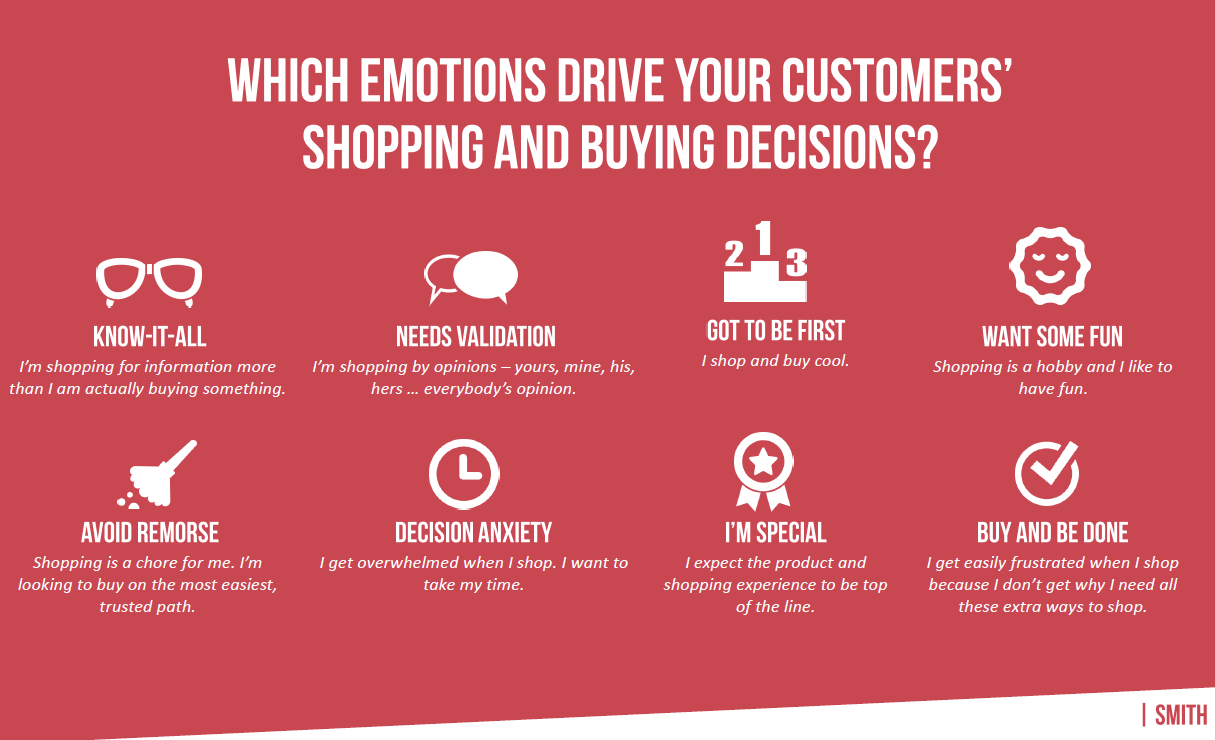
I know I’ve mentioned Joseph Sugarman a few times so far, but he’s my favourite writer. He gave the example once of luxury cars.
Someone shopping for a high-end car most likely is interested in the status and image it gives them. A.K.A, it’s all driven by emotion.
But, what do they justify it with? Logic!
They start looking at the gas mileage, seat warmers, high-quality materials and believe that’s why they are buying it.
5. Forgetting about SEO
Sure, copywriting is all about convincing and selling, but if you don’t have people reading it, you don’t make any money.
That’s why I highly recommend always using SEO when writing. Product pages are a great place to nail good SEO practices because it’s where all of the magic happens.
How do you make good SEO product pages? With keywords.
Open up Google’s Keyword Planner and enter a keyword related to what you’re selling.
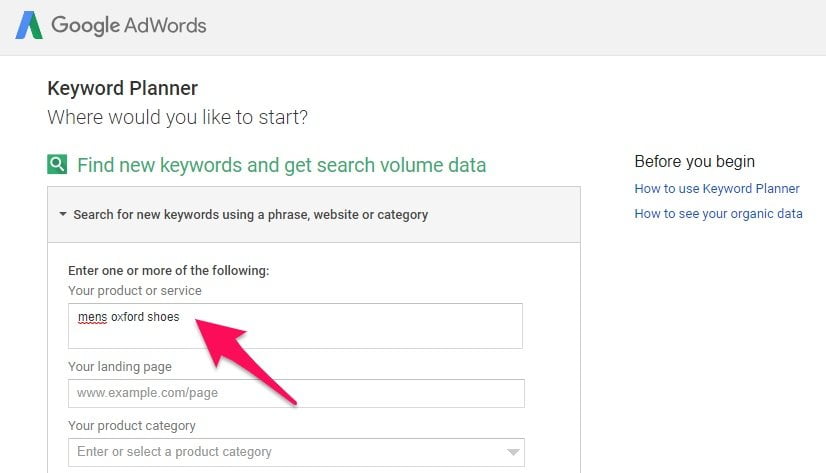
Narrow down the targeting and other options if you’d like, though it isn’t usually necessary.
This will display tons of keyword ideas you can use on your product pages.

Where do you add them? Try:
- In the title
- In the URL
- In the description
- As product tags
- For product categories
This will help you rank for these keywords and since they have high buying intent, they could very well translate to many sales.

Almost 40% of sales are a result of organic search. That alone should motivate you to get your SEO intact.
As consumers are becoming more aware of advertising, allowing them to organically navigate to your business is more crucial than ever.
Besides your product page, you can implement keywords into your about page, the home page, and other sections. If you don’t already, you should also be investing in content marketing that is based completely on SEO.
It helps drive traffic and sales to your website, especially as you can add your own products within articles.
It’s really easy to begin, too.
Blog about topics that you believe your target audience would be interested in. Use the Keyword Planner to research a few different keywords to center every post around.
When it makes sense, promote your own products or service within the content. Don’t do it too often or they will feel like they are being advertised to.
Writing consistent articles allows you to practice copywriting. You can test out different strategies and put everything you learn into action.
6. Not speaking in a conversational manner
Sales copy isn’t supposed to read like a boring college textbook.
I don’t know about you, but I’ve read enough of those! 😴
Instead, sales copy needs to read like a friend speaking to a friend.
A conversation at a bar…
How you talk to someone over coffee…
This means you are going to break some grammatical rules. You are going to annoy linguistics. You will go against things you’ve been taught.
Read any of the best copywriting material of all time and you’ll see a consistent pattern: they use a casual, personal, and friendly writing style.
This helps connect to the reader and make them more comfortable. It pushes them along the sales copy until the end where they take action.
But, how do you accomplish this?
Frankly, it takes practice. You’re probably used to writing boring and average material.
Read the copy in your head and write it the same way.
Let it flow from your fingers and avoid stopping to over-analyze.
This makes writing more emotional, creative, interesting, and conversational.
7 Using the incorrect tone of voice or personality
Every advertisement needs to harmonize and resonate with the reader.
They want to feel like you get them. You understand them. You’re like them.
It’s important to speak from the correct frame and tone of voice for this reason.
Otherwise, it might not match who they are and they’ll disappear from the sale page.
Imagine you’re writing to millennials. While saying things like “It’s lit!” and “What’s Gucci?” will instantly reveal you as being 50+, you would probably write in a much more casual way.
You’d use simple words. Memes. Gifs. Funny analogies. Events and experiences that specific age group can relate to.
If you were writing for CEO baby boomers, on the other hand, they might appreciate more straightforward and authoritative material.
Overall, make sure that you’re matching the tone of voice to the person that’s reading it.
8. Basing sales copy on assumptions
What are your customer’s pain points? Objections? Feelings? Desires?
Do you know these things or are you assuming them?
It’s okay when you’re brand new to an industry or business to have some theories and ideas.
Eventually, these facts need to be concrete.
Otherwise, you risk writing sales copy that people don’t care or about or engage with. (And that means no revenue!)
How do you find out who you’re truly writing for?
The first step as I mentioned earlier is by using a buyer persona. This maps out the customer’s demographics, psychographic, etc.
Copywriters can produce much higher converting ads when they understand every detail of the reader.
I recommend using a combination of the following resources to create and refine a buyer persona:
- Testimonials
- Reviews
- Case studies
- Social media and forum conversations
- Market reports
- Competitors
- Customer feedback
- Interviews and surveys
All of these things will give you massive insights into the target audience.
9. Using too much jargon and confusing readers
You’re not impressing anyone with a fancy vocab.
In fact, it’s probably hurting you.
Let me explain.
The average reading level for American’s is believed to be 7th grade.
That means if you write with complex words and ideas, the advertisement will confuse a majority of people.
On the flip side, you could use a simple and easily understandable language to reach the most amount of people.
Think about it like this…
If you write simple ads, everyone from the Tesla engineer to the average Joe can grasp it.
I’ll be showing you how to use a tool called Hemingway App to measure metrics like reading level later. 👇
10. A lack of credibility
If it sounds too good to be true, it probably is.
That’s something a lot of customers are going to think when they read an ad.
Hence why it’s critical to include credibility-building elements.
Without these, people won’t believe the claims you make or convert.
The first type of credibility (and the easiest) to use is statistics and data.
You can source studies and stats related to what you’re writing about.
Not only does this provide more context and proof but it makes your business appear more credible.
Imagine we were writing sales copy for a ketogenic health offer. We could Google “Ketogenic studies” and have thousands of studies at our fingertips.
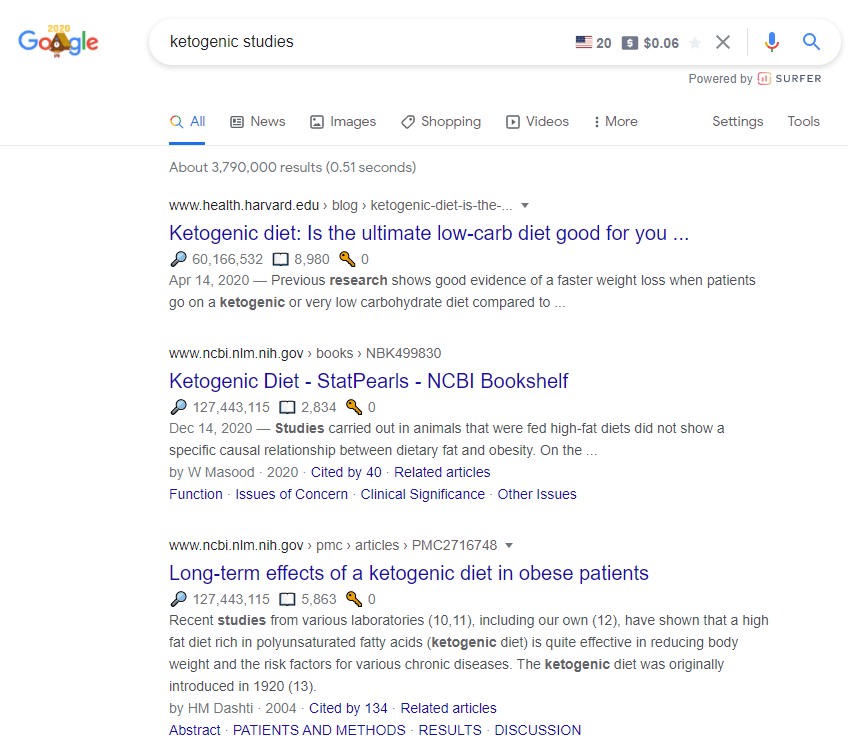
Secondly, quotes. Using quotes from experts, doctors, customers, or your team is very effective. It shows that other people can vouch for the product.
Displaying awards and achievements you’ve won is another common way to build credibility.
The digital agency Bluewater regularly publishes content about accomplishments like being named one of the fastest-growing companies.
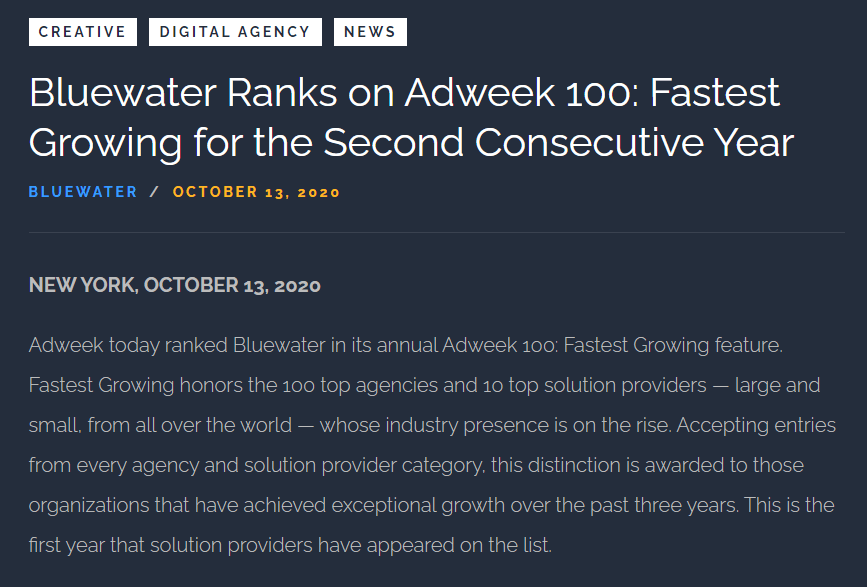
11. Where’s the call to action?
One of the most common copywriting mistakes to avoid is forgetting calls to action.
These are words or phrases that tell the customer what to do next.
While they seem rudimentary, they’re 100% essential.
CTAs push people to buy products, opt into newsletters, and perform other key actions.
Without them, response plummets.
Calls to action should be placed continually through an ad. Strike a delicate balance.
You may have CTAs for reading more of an ad, imagining a certain outcome, and then purchasing.
Try to not overuse them. At a minimum, there needs to be one main call to action that services the primary goal.
That brings me to my next point.
12. Too many offers at once
Marketing and copywriting is all psychology. 🧠
When we are presented with too many offers, we begin to feel negative emotions and are less likely to take action at all.
It becomes confusing. We have to think too much.
This is called the paradox of choice.
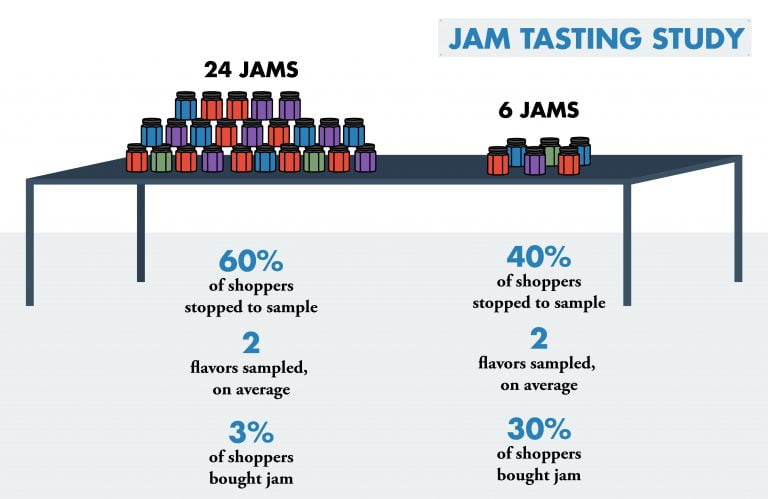
Rather, if we’re presented with a single option, we can only say “Yes” or “No.”
It’s a normal copywriting mistake to offer too many things at once.
There should be a core offer for every page. Try not to deviate.
Bonuses and freebies can be mentioned later on in separate sections.
Take the SEO software ClickFlow for example.
When you land on the homepage, there’s a call to action for getting a demo.
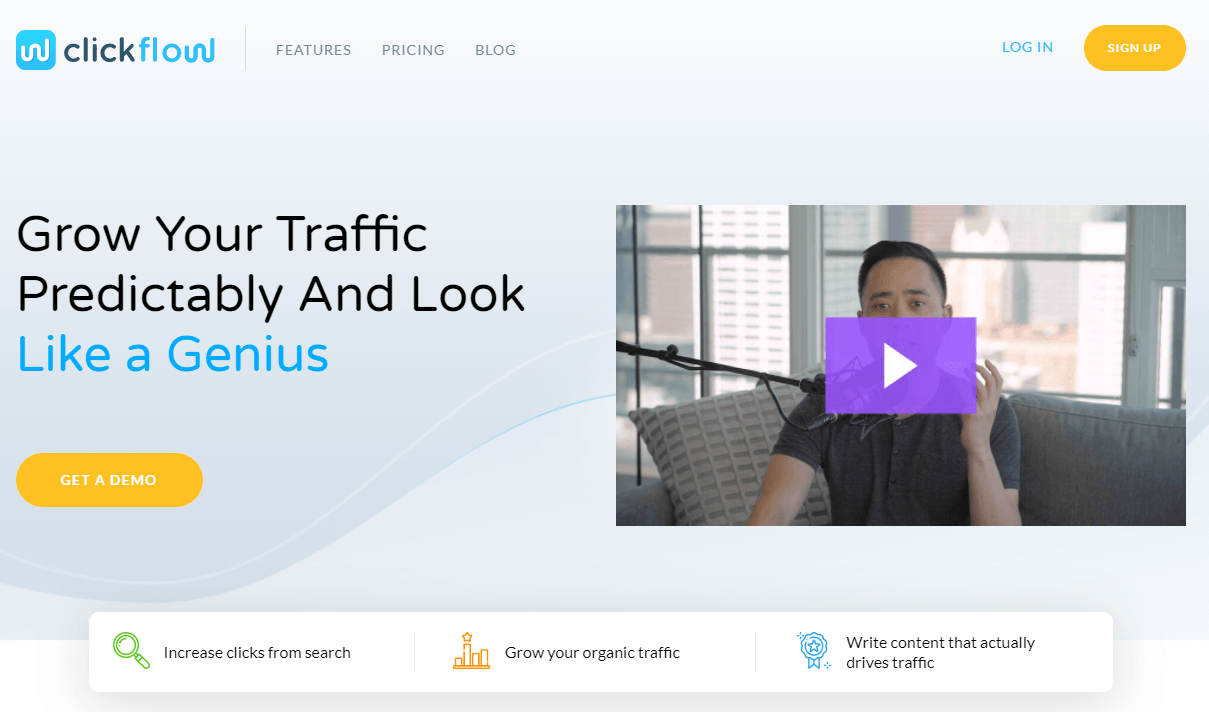
As you scroll through the page, calls to action for the demo continue.

ClickFlow understands that there needs to be one main offer per page and they thrive because of it.
13. Weak formatting and structure
Your sales copy shouldn’t be giant blocks of black and white text.
That’s a surefire way to get people to run away.
It needs to be easy to read and entertaining.
This is accomplished through good formatting and structure.
I recommend using short sentences and paragraphs if possible.
It is easier on the eyes and makes flowing through the material faster.
Take advantage of bullet points and lists to quickly summarize information and communicate value.
Bold, italicize, and underline important words or sentences.
Include relevant images, charts, graphs, and videos.
Ideally, these provide more context and stimulate emotions in the customer.
Avoid using stock photos that achieve nothing other than decreasing the quality of the copy.
Use header tags to break up the different sections and ideas throughout the ad.
Seeing as most people skim content, it will help them find the most important piece of information they’re seeking.
14. No testimonials or reviews
What’s one of the first things that customers look for when purchasing a product or service?
Testimonials…
Case studies…
Reviews…
They want to see that other people spent their hard-earned money and were happy with what you provided.
It’s a form of social proof and plays into psychology.
By leveraging group think (what other people are saying), the customer can save time and headaches by making a quicker decision.
I’m always taken back by the lack of testimonials on sales pages and websites despite this.

And you know what? 92% of people look for reviews before buying something online. They’re 100% mandatory.
The first step is following up with customers and asking for a testimonial.
Let them know it’ll be published within marketing material and you’d greatly appreciate the feedback as it helps grow the business.
You’ll be pleasantly surprised by how many people will happily give you a testimonial.
All you need is a sentence or two but if they want to give you more, that’s great!
Video testimonials also crush it.
Leverage these as much as possible.
The best place for them is sales pages, product pages, sales letters, and anything close to the point of sale.
You can also share them on social media and through email newsletters as content.
Integrate them into your website to create authority, credibility, and trust.
Look how the digital agency TaleBone uses client reviews to increase conversion on its homepage.
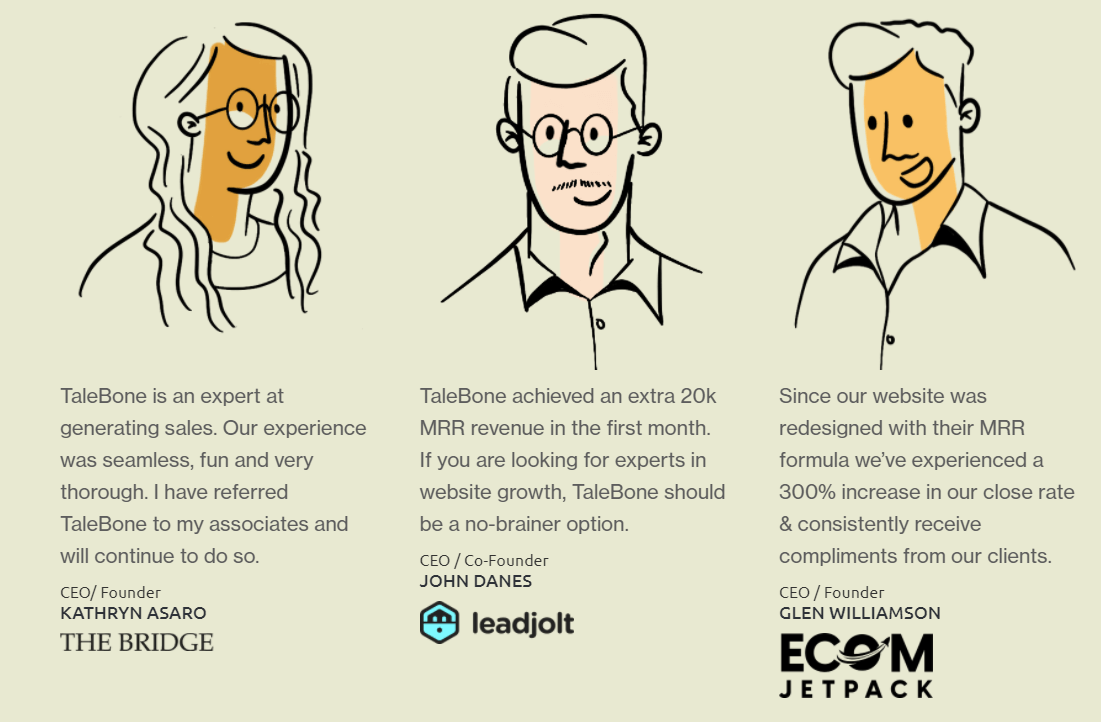
15. Forgetting the guarantee
Overcoming objections and making customers as comfortable as possible is a huge part of copywriting.
And what’s one of the best ways to do so?
By providing a guarantee.
…Something that makes it 100% impossible for the customer to lose.
The most common guarantee is a money-back guarantee. This might be 30 days, 60 days, etc.
It makes the transaction completely risk-free. The customer can purchase the product and if they don’t want it after, their money is returned.
Another one to consider is a warranty. This is important for technology and complicated products that may wear or break.
Think of phones, cars, televisions, etc. They always come with a warranty in case it needs to be replaced … resolving a common objection to these pricy items.
For example, I provide 30 day money-back guarantees for the online courses I sell.
Firstly, it is presented at the end of the sales page within an FAQ section.
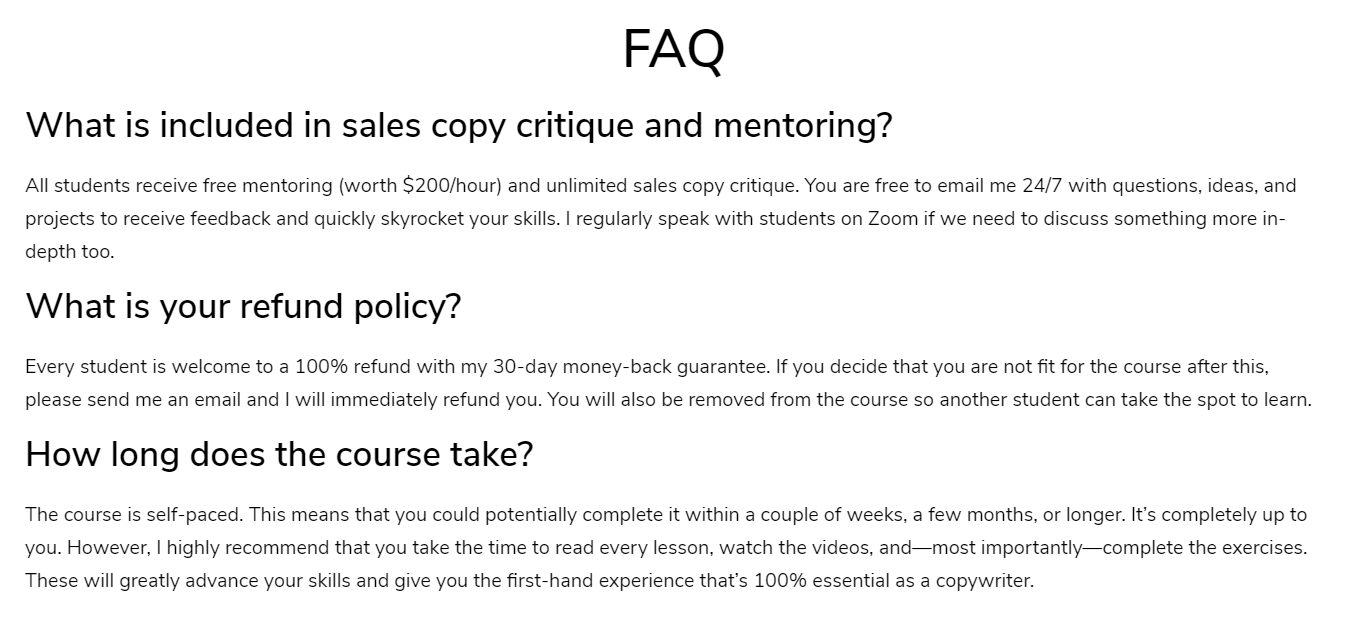
Then, I also place it on the checkout page so they are once again reminded there is nothing to lose.
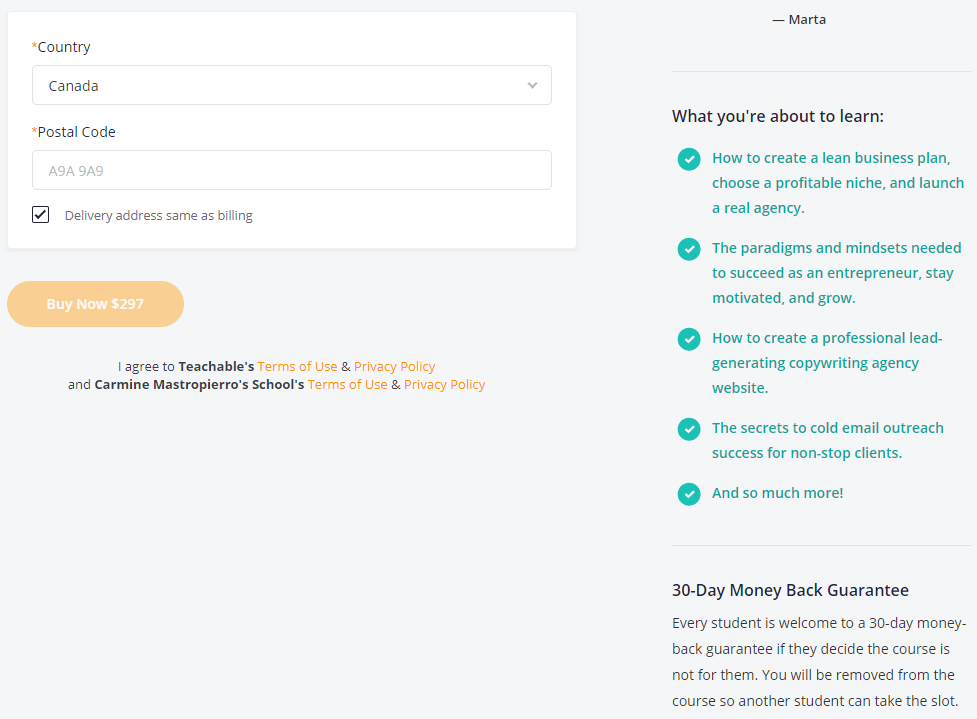
16. Careless grammar and spelling mistakes
I’m no saint.
I’ve made careless spelling and grammar mistakes in sales copy before.
But, I’ve learned my lesson.
I make sure to use a thorough copyediting or proofreading checklist.
…Something I can go through every time I write.
There are some main elements you should review every time you edit. They include:
- Spelling
- Grammar
- Punctuation
- Logical flow
- Technical jargon
- Proper sourcing of images
- Format and structure
- Citations and footnotes
Make it a habit to look through a list like this after writing the first draft of every campaign.
Doing so will ensure the final product is as crisp as possible. Not only will it generate a better response but clients will be happier too.
That takes a lot of work though. Let’s take a shortcut…
Pull up Hemingway Editor and paste in the sales copy.

This will automatically tell you where you should fix it. It also gives you hints about passive speak, hard to read sentences, and adverbs.
Keep in mind that sometimes you want these things for strategic reasons. Use any suggestions as just that, a recommendation.
Wrapping up the worst copywriting mistakes to avoid
Copywriting can make or break your business.
Do it right and you will experience huge growth in sales or leads.
Many times you might be making mistakes within your copy that you aren’t even aware of. The first being that there is a lack of benefits.
Tell the customer what they are going to get out of it. Having only the features is dry and doesn’t bring out any emotion in the audience.
Secondly, take the time to craft awesome headlines. Ones that catch attention and pique interest. Use urgency, numbers, or questions to achieve this.
Ensure that you don’t speak too much about yourself or the business. Get the needed information in but speak in the customers’ language. Are they going to find affordable products? Will it solve their problems? Think like this.
The purchasing process is emotional. So, it only makes sense to include emotion within our copywriting. Tell stories, make the audience happy, excited, or nervous. This will make them crave more.
Lastly, don’t forget about good ole’ SEO. Research keywords related to your business and include them within your sales copy. Whether that’s the product page or a blog post, make sure all of your bases are covered.
What copywriting mistakes do you try to avoid?















